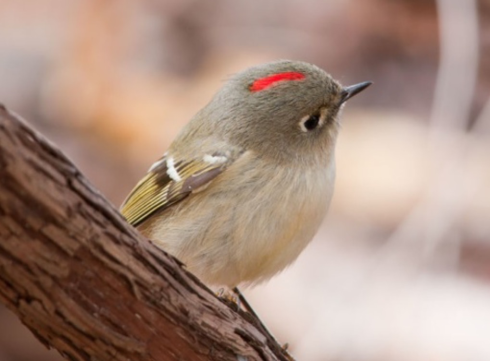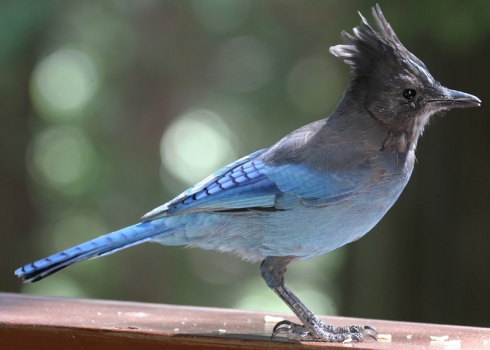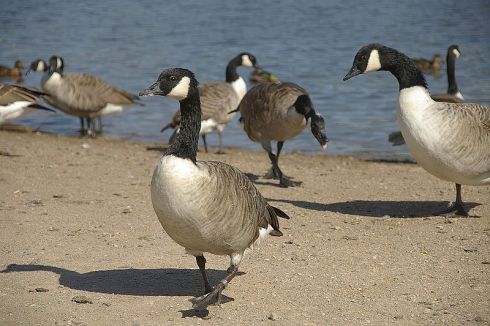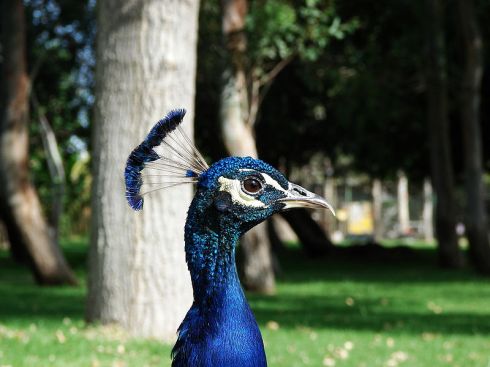You are currently browsing the category archive for the ‘Birds of Hart Park’ category.
I was looking through the front window on this chilly AM in Bakersfield, CA and in one of the dormant crape myrtle trees lining the front yard danced a most beautiful bird – a Ruby Crowned Ringlet (see pic below). What a wonderful way to start the morning admiring this color filled and delightful sounding little bird. Confirmed the spotting using the Merlin app. Nice call and song too. The small ruby-red stripe on the little bird’s head was the give-away. This one is a male. Nice brown, yellow, and black plumage too. The Ringlet is loving the barren limbs and dried buds. Oh my, another one – it’s a female! They have migrated from their normal mating area in the mountains. Kind of rare to see one in the San Joaquin Valley. We are living in paradise for sure!
Oh yes, what made this a perfect year? The year was filled with awareness, love, and health!
I hope everyone enjoyed Hart Park this year!!!! We did!!!! It’s beautiful!!!!
Wishing everyone a most joyous new year!
Pictures taken by Tara Nelson, circa September 2010. Thank you Tara.
Tara is a Founding Member of the Stewards of Hart Park.
All, please feel free to submit your pictures of Hart Park to stewardsofhartpark@gmail.com. We will post them here for all to enjoy.

“Wood Duck In Paradise” Photo by Greg Iger, February 2010
“This is a fantastic picture of a male Wood Duck, which are relatively common at Hart Park. The female is much more subdued in color, mostly gray with whitish markings, but beautiful as well. It’s possible that the Wood Ducks are nesting on that island in the lake, which would be great!” Madi Elsea, National Audubon Society
This colorful duck is a common site at our great park and typically found close to water. The Wood Duck is one of only a few North American ducks that nest in trees. Many people consider it to be the most beautiful of all waterfowl.
They are a game bird, oh my! second only to the Mallard, however, in our park and surrounding areas they are safe, our at peace and thrive.
The Wood Duck nests in trees near water, sometimes directly over water. After hatching, the ducklings jump down from the nest tree and make their way to water. The mother calls them to her, but does not help them in any way. The ducklings may jump from heights of up to 290 ft without injury. Wild!
Wood Ducks pair up in January and regularly produces two broods in one year.
The Wood Duck eats Seeds, acorns, fruits, aquatic and terrestrial invertebrates. We have lots of acorns our park. They love it here.
They nest in preformed cavities in trees lined with down from the female’s breast.
Their Dabblers, they move rapidly and peck and dabble on the water surface. The may tip-up or dive for submerged food items.
“The Rose-Ringed Parakeets are part of a flock of about 3000 that live throughout Bakersfield, including Hart Park. The legend is that they were established after the Dust Storm of 1977 when an aviary might have gotten destroyed and the birds got loose. A lot of them roost at night in the palm trees along California Ave & Union. We have a small flock in our neighborhood, numbering around 30. Beautiful birds, but not natives! ” Madi Elsea – Audubon Society
The Rose-ringed Parakeet (Psittacula krameri), also known as the Ringnecked Parakeet, is a gregarious tropical parakeet species that is popular as a pet. Its scientific name commemorates the Austrian naturalist Wilhelm Heinrich Kramer.[1]
This non-migrating species is one of few parrot species having successfully adapted to living in ‘disturbed habitats’, and in that way withstood the onslaught of urbanisation and deforestation. In the wild, this is a noisy species with an unmistakable squawking call.
The adult male sports a black neck-ring and pink nape-band while the hen and immature birds of both sexes either show no neck rings, or display shadow-like pale to dark grey neck-rings and light (lighter coloured than surroundings) nape-bands.
Below, we see a male and female resting at their home at the Park, getting ready for a night of rest. Certainly much deserved after a day of squawking at people like me!

Merrily Swimming along at Hart Park – Greg Iger, Jan 9, 2010
This Duck is a winter only visitor from Northern Canada.
A small fish-eating duck of wooded ponds, the Hooded Merganser nests in holes in trees. It is frequently seen on shallow waters where its only waterfowl companion is the Wood Duck.
The Hooded Merganser is the second-smallest of the six living species of mergansers (only the Smew of Eurasia is smaller) and is the only one restricted to North America.
Although up to 44 Hooded Merganser eggs have been found in one nest, one female probably does not lay more than about 13. Larger clutches result when more than one female lays eggs in a nest.
The Hooded Merganser finds its prey underwater by sight. The merganser can actually change the refractive properties of its eyes to enhance its underwater vision. In addition, the nictitating membrane (third eyelid) is very transparent and probably acts to protect the eye during swimming, just like a pair of goggles.
Measurements
Both Sexes
Length
15.7–19.3 in
40–49 cm
Wingspan
23.6–26 in
60–66 cm
Weight
16–31 oz
453–879 g
Other Names
Harle Couronné (French)
Serreta capuchona (Spanish)
The Northern Flicker is a member of the Woodpecker family. They are also known as the Red-shafted Flicker because of the beautiful orange color on the edge and underneath their wings, which is conspicuous in flight.
They like to feed on the ground for ants and other bugs.
They are migratory and are found in Hart Park (and surrounding areas) during the winter.
Thank you Madi for your help identifying and describing this bird.
Another great part of Hart Park are the Birds. Did you know there have been at least 231 different species of Birds recorded at the park! Mind boggling.
Visitors enjoy coming to Hart Park to feed the Ducks. I do too. I like bringing old bread to use as feed. The Ducks really like this stuff.
I hope you have a chance when you visit the park to have a close look. The birds are beautiful and so peaceful, well, except for maybe the large flock of parrots whom have decided to make Hart Park their home 🙂 I like to take a simple pair of binoculars to the park with me to see them really close up – Wow!
Below is a Link to a listing of the Birds of Hart Park. A special thanks to Ali Sheehey and the Audubon Society for all the hard work putting this list together. Ali’s site is spectacular.













Recent Comments